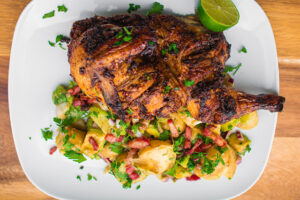INSULIN DOSING FOR TYPE 1 DIABETES – MORE THAN JUST CARBS

People with type 1 diabetes essentially don’t produce any insulin of their own, so need to replace the insulin their body isn’t making, by injection or using an insulin pump. They then need to balance the amount of insulin they take with food and beverage intake, physical activity levels and other factors, with the aim of keeping blood glucose levels within a specific target range.
Traditionally, the dietary management of type 1 diabetes has largely focused on carbohydrate counting and matching insulin to carbohydrate intake. This is because carbohydrate-containing foods have the most significant impact on blood glucose levels.
However, there is increasing evidence that both fat and protein intakes influence the blood glucose response to a meal, and may need to be considered when deciding on insulin doses and timing. The glycemic index of a food or meal can also affect insulin dosing. This has become even more apparent with the increasing use of continuous blood glucose monitoring.
Fat lowers the blood glucose response soon after a meal, delays the peak in blood glucose levels, and leads to higher blood glucose levels several hours after the meal. However, the response to fat varies widely between individuals and also depends on the amount of fat in the meal.
Protein also causes a later rise in blood glucose levels and the effects are different when protein is eaten with and without carbohydrate. This means that a meal containing protein alone may need a different insulin dosing strategy to a meal which combines protein with carbohydrate.
The impact of fat and protein are additive, so a meal that is high in both fat and protein will probably need more insulin than a meal that is high in only one of these.
With glycemic index (GI), studies have shown that lower GI foods or meals can lower the glycaemic response and reduce the likelihood of high blood glucose levels after eating, even when the same amount of available carbohydrate is consumed. However, some studies have also shown an increased risk of mild hypoglycaemia (low blood glucose levels) in people with type 1 diabetes, following lower GI meals, which may need to be considered when deciding on the timing of pre-meal insulin doses.
What all this means is that simply carb counting and basing insulin doses on the amount of available carbs eaten is unlikely to achieve optimal blood glucose levels in someone with type 1 diabetes. This is reflected in the American Diabetes Association 2022 Standards of Medical Care in Diabetes, which now include in their recommendations that insulin dosage should not be based solely on carbohydrate counting when a meal is high in fat and/or protein. However, further research is needed, along with easy-to-use algorithms (mathematical equations), to help individuals with diabetes learn how to adjust insulin doses for carbohydrate, fat and protein.
If you have type 1 diabetes and find that carb counting alone is not always working to manage your post-meal glucose levels, your diabetes health professionals can help you understand more about how to adjust your insulin, considering fat and protein. And while the research to date has been in people with type 1, these findings may also apply to individuals with type 2 diabetes who are taking insulin, particularly those who are producing very little insulin of their own (i.e., those who have had type 2 diabetes for a long time).
Read more:
- Bell and colleagues. Impact of fat, protein, and glycemic index on postprandial glucose control in type 1 diabetes: implications for intensive diabetes management in the continuous glucose monitoring era. Diabetes Care. 2015.
- Paterson and colleagues. The Role of Dietary Protein and Fat in Glycaemic Control in Type 1 Diabetes: Implications for Intensive Diabetes Management. Curr Diab Rep. 2015.
- Metwally and colleagues. Insulin pump dosing strategies for meals varying in fat, protein or glycaemic index or grazing-style meals in type 1 diabetes: A systematic review. Diabetes Res Clin Pract. 2021.
- American Diabetes Association Professional Practice Committee. D. 5. Facilitating Behavior Change and Well-being to Improve Health Outcomes: Standards of Medical Care in Diabetes-2022. Diabetes Care. 2022.

Dr Kate Marsh is an is an Advanced Accredited Practising Dietitian, Credentialled Diabetes Educator and health and medical writer with a particular interest in plant-based eating and the dietary management of diabetes and polycystic ovary syndrome (PCOS).
Contact: Via her website www.drkatemarsh.com.au







